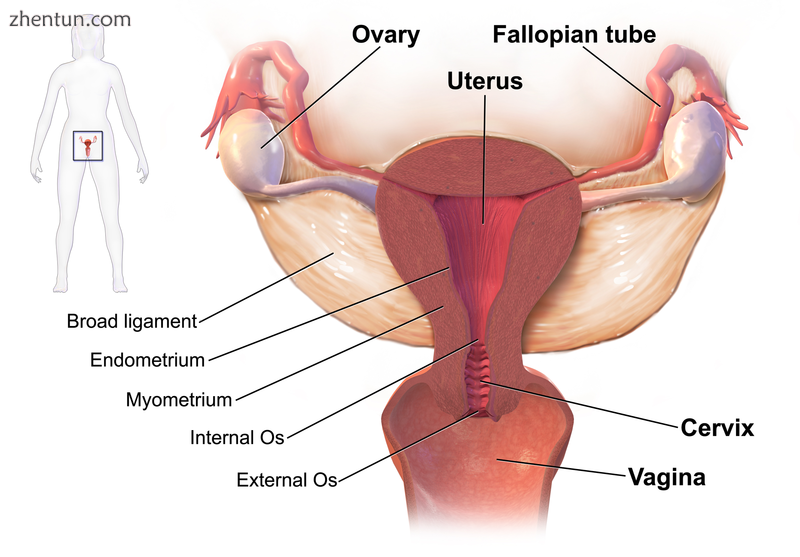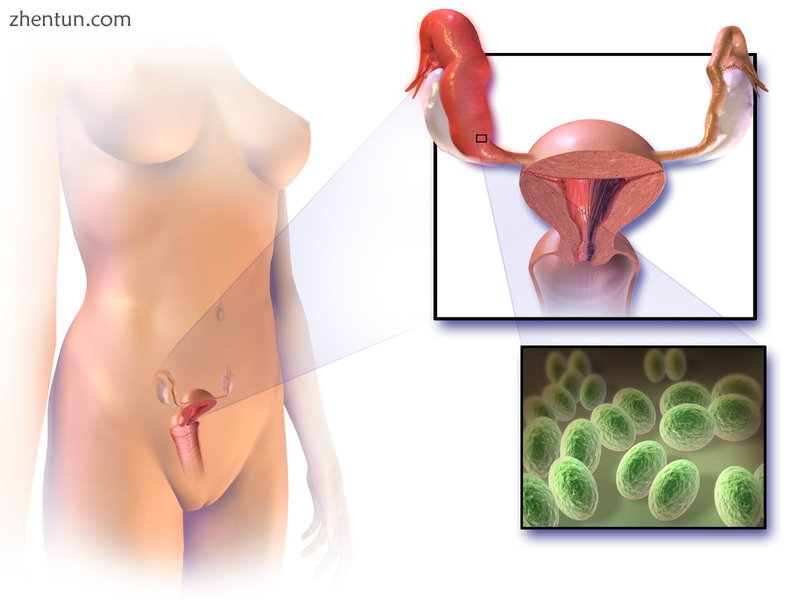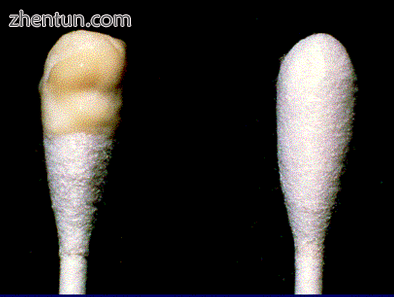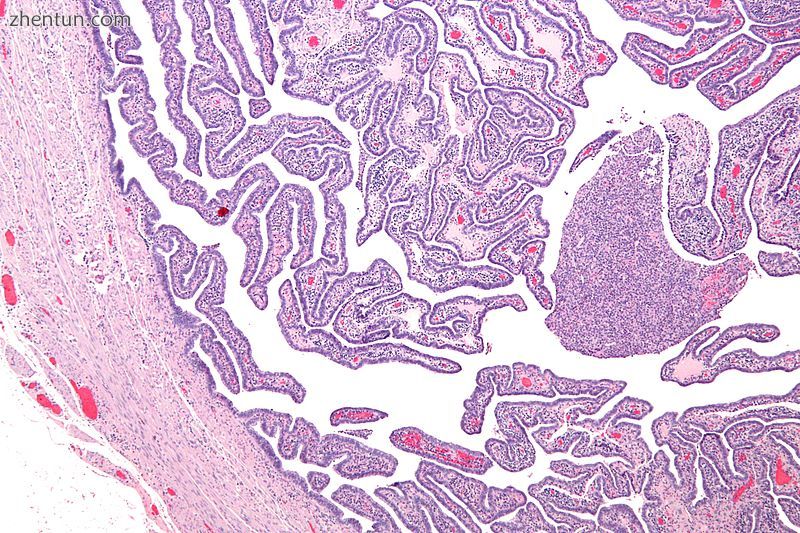盆腔炎(PID),是女性生殖系统上部的感染,即子宫,输卵管和卵巢,以及骨盆内部[5] [2]。通常,可能没有症状。[1]症状和体征,如果存在,可能包括下腹痛,阴道分泌物,发烧,排尿灼热,性交疼痛,性交后出血或月经不调。[1]未经治疗的PID可导致长期并发症,包括不孕症,异位妊娠,慢性盆腔疼痛和癌症。[2] [3] [4]
这种疾病是由从阴道和子宫颈传播的细菌引起的。[5] 75%至90%的病例中存在淋病奈瑟菌或沙眼衣原体感染。[2]通常,涉及多种不同的细菌。[2]如果不进行治疗,大约10%的衣原体感染者和40%的淋病感染者会发生PID。[2] [9]风险因素通常与性传播感染相似,包括大量性伴侣和吸毒。[2]阴道冲洗也可能增加风险。[2]诊断通常基于呈现的体征和症状。[2]建议所有患有下腹痛的育龄妇女都要考虑这种疾病。[2]通过在手术期间发现涉及输卵管的脓液来确定PID的确诊。[2]超声也可用于诊断。[2]
预防这种疾病的努力包括不发生性行为或性伴侣少和使用安全套。[6]筛查有衣原体感染风险的妇女接着治疗可降低患PID的风险。[10]如果怀疑有诊断,通常建议进行治疗。[2]也应该治疗女性的性伴侣。[10]在有轻度或中度症状的患者中,建议单次注射抗生素头孢曲松,连同两周多西环素和口服甲硝唑[7]。对于那些三天后没有改善或患有严重疾病的人,应该使用静脉注射抗生素。[7]
在全球范围内,2008年发生了约1.06亿例衣原体病例和1.06亿例淋病。[9]然而,PID的病例数目并不清楚。[8]据估计,每年约有1.5%的年轻女性受到影响。[8]在美国,估计PID每年影响约100万人。[11]一种被称为Dalkon盾的宫内节育器(IUD)导致了20世纪70年代PID的增加。[2]目前的宫内节育器在第一个月后与此问题无关。[2]

绘图显示盆腔炎的常见感染部位
目录
1 症状和体征
1.1 并发症
2 原因
2.1 细菌
3 诊断
3.1 鉴别诊断
4 防治
5 治疗
6 预后
7 流行病学
8 参考
体征和症状

盆腔炎的例证
PID的症状范围从无到严重。如果有症状,那么可能会出现发烧,运动压痛,下腹痛,新出血或不同出院,性交疼痛,子宫压痛,附件压痛或月经不调等。[2] [1] [12] [13]
其他并发症包括子宫内膜炎,输卵管炎,输卵管卵巢脓肿,盆腔腹膜炎,肛周阑尾炎和肝周炎。[14]
并发症
PID可导致生殖系统内部的瘢痕形成,这可能导致严重的并发症,包括慢性盆腔疼痛,不孕,异位妊娠(成年女性妊娠相关死亡的主要原因),以及其他妊娠并发症。[15]偶尔,感染可能会扩散到腹膜,引起肝脏外表面炎症和瘢痕组织的形成(Fitz-Hugh-Curtis综合征)。[16]
原因
沙眼衣原体和淋病奈瑟菌通常是PID的主要原因。数据表明PID通常是多微生物的。[14]从上生殖道获得了分离的厌氧菌和兼性微生物。从输卵管中分离出淋病奈瑟氏球菌,从子宫内膜组织中回收了兼性和厌氧生物[17] [18]。
女性生殖道内部器官和组织的解剖结构为病原体通过漏斗提供从阴道上升到盆腔的途径。与细菌性阴道病相关的自然发生的阴道微生物群的紊乱增加了PID的风险。[17]
淋病和沙眼衣原体是最常见的生物。 最不常见的是仅由厌氧菌和兼性生物引起的感染。 从50%回收衣原体和奈瑟菌的患者中也分离出厌氧菌和兼性细菌; 因此,在近三分之二的PID患者的上生殖道中存在厌氧菌和兼性细菌。[17] PCR和血清学检测将非常苛刻的生物体与子宫内膜炎,PID和输卵管因子不育相关联。 与PID相关的微生物如下所列。[17]
很少有PID病例发生在那些声称从未发生性行为的人身上。[19]
诊断

在棉签上看到的粘液脓性宫颈分泌物

输卵管炎的显微照片 - 盆腔炎的一个组成部分。 H&E染色。
在进行骨盆检查时,将会出现颈椎运动,子宫或附件压痛。[5]可以观察到粘液脓性宫颈炎和/或尿道炎。在严重的情况下,可能需要进行更多的检测,如腹腔镜检查,腹腔内细菌取样和培养,或组织活检。[14] [21]
腹腔镜检查可以看到“小提琴弦”粘连,这是Fitz-Hugh-Curtis perihepatitis和其他可能存在的脓肿的特征。[21]
其他成像方法,如超声波检查,计算机断层扫描(CT)和磁成像(MRI),可以帮助诊断。[21]血液检查还可以帮助确定是否存在感染:红细胞沉降率(ESR),C反应蛋白(CRP)水平以及衣原体和淋球菌DNA探针。[14] [21]
核酸扩增试验(NAATs),直接荧光素试验(DFA)和酶联免疫吸附试验(ELISA)是高度敏感的试验,可以识别存在的特定病原体。抗体的血清学检测不是很有用,因为健康人群中微生物的存在会使解释抗体滴度水平变得混乱,尽管抗体水平可以表明感染是近期还是长期。[14]
确定的标准包括子宫内膜炎的组织病理学证据,填充的输卵管增厚或腹腔镜检查结果。革兰氏染色/涂片在鉴定稀有,非典型和可能更严重的生物体时变得明确。[22]三分之二的患有腹腔镜检查的先前PID的患者不知道他们患有PID,但即使是无症状的PID也会造成严重的伤害。
腹腔镜识别有助于诊断输卵管疾病;假定PID的患者存在65%至90%的阳性预测值。[23]
在妇科超声检查中,一项潜在的发现是输卵管卵巢复合体,这是一种水肿和扩张的骨盆结构,边界模糊,但没有脓肿形成。[24]
鉴别诊断
许多其他原因可能会产生类似的症状,包括阑尾炎,异位妊娠,卵巢囊肿出血或破裂,卵巢扭转,子宫内膜异位症和胃肠炎,腹膜炎和细菌性阴道病等。[2]
当有感染史,最近的性接触,近期月经发作或宫内节育器(宫内节育器)到位或伴侣有性传播感染时,盆腔炎更可能再次发生。[25]
当最近的性交未发生或未使用宫内节育器时,急性盆腔炎不太可能发生。通常获得敏感的血清妊娠试验以排除异位妊娠。 后穹窿穿剌术将区分腹腔积液(破裂的异位妊娠或出血性囊肿)与盆腔脓毒症(输卵管炎,盆腔脓肿破裂或阑尾破裂)。[26]
盆腔和阴道超声检查有助于PID的诊断。在感染的早期阶段,超声可能看起来正常。随着疾病的进展,非特异性发现可包括游离盆腔积液,子宫内膜增厚,子宫腔扩张液体或气体。在某些情况下,子宫和卵巢的边界看起来模糊不清。扩大的卵巢伴随着小囊肿数量的增加与PID相关[26]。
腹腔镜检查很少用于诊断盆腔炎,因为它不容易获得。此外,它可能无法检测到输卵管的细微炎症,也无法检测到子宫内膜炎。[27]然而,如果诊断不确定或48小时后该人未对抗生素治疗有反应,则进行腹腔镜检查。
没有一项测试具有足够的敏感性和特异性来诊断盆腔炎。美国一项大型多地点研究发现,颈椎运动压痛作为最低临床标准,将CDC诊断标准的敏感性从83%提高到95%。然而,即使修改后的2002年CDC标准也未确定患有亚临床疾病的女性。[28]
预防
鼓励对性传播感染进行定期检测以进行预防。[29]通过以下方式可以降低患盆腔炎的风险:
使用安全套等屏障方法;看到其他列表的人类性行为。[30]
如果您遇到PID症状,请就医。[30]
使用激素联合避孕药也有助于通过增加宫颈粘膜栓来减少PID的机会,从而防止致病生物从下生殖道上升。[30]
在得知当前或以前的性伴侣有或可能有性传播感染后,寻求医疗照顾。[30]
从您当前的伴侣那里获得STI病史并强烈鼓励他们在性交前接受检测和治疗。[30]
在怀孕(分娩,流产或堕胎)或某些妇科手术结束后,尽量避免阴道活动,特别是性交,以确保子宫颈闭​​合。[30]
减少性伴侣的数量。[25]
性一夫一妻制。[31]
禁欲[30]
治疗
由于治疗延迟可能导致严重的并发症,因此通常在没有确认感染的情况下开始治疗。治疗取决于感染因子,并且通常涉及使用抗生素治疗,尽管没有明确证据表明哪种抗生素治疗方案在治疗PID方面更有效和安全。[32]如果在两到三天内没有改善,通常建议患者寻求进一步的医疗护理。如果有其他并发症,有时需要住院治疗。为性伴侣治疗可能的性传播感染可以帮助治疗和预防。[10]
对于PID轻度至中度严重的女性,肠外和口服治疗似乎是有效的。[33] [34]对于他们的短期或长期结果,抗生素是作为住院患者还是门诊患者给予他们无关紧要。[35]典型的方案包括头孢西丁或头孢替坦加多西环素和克林霉素加庆大霉素。另一种肠外方案是氨苄青霉素/舒巴坦加多西环素。也可以使用基于红霉素的药物。[36]一项研究表明阿奇霉素优于强力霉素[32]。另一种方法是使用头孢曲松或头孢西丁加强力霉素的肠外方案。[25]临床经验指导了从肠外治疗到口服治疗的决定,通常可在临床改善后24-48小时内开始。[27]
预测
即使PID感染治愈,感染的影响也可能是永久性的。这使得早期识别至关重要。导致治愈的治疗对于预防生殖系统的损害非常重要。由于一次或多次PID发作而形成瘢痕组织可能导致输卵管阻塞,增加无法怀孕和长期骨盆/腹痛的风险。[37]某些事件,如骨盆手术后,分娩后(产后),流产或堕胎后的一段时间,会增加获得另一种导致PID的感染的风险。[25]
流行病学
全球约有1.06亿例衣原体病例和1.06亿例淋病发生在2008年。[9] PID的个案数量;但是,目前尚不清楚。[8]据估计,每年约有1.5%的年轻女性受到影响。[8]在美国,PID估计每年影响约100万人。[11]青少年和初次母亲的比率最高。 PID导致每年有超过100,000名女性在美国患上不孕症。[38] [39]
参考:
"Pelvic Inflammatory Disease (PID) Clinical Manifestations and Sequelae". cdc.gov. October 2014. Archived from the original on February 22, 2015. Retrieved February 21, 2015.
Mitchell, C; Prabhu, M (December 2013). "Pelvic inflammatory disease: current concepts in pathogenesis, diagnosis and treatment". Infectious Disease Clinics of North America. 27 (4): 793–809. doi:10.1016/j.idc.2013.08.004. PMC 3843151. PMID 24275271.
Chang, A. H.; Parsonnet, J. (2010). "Role of Bacteria in Oncogenesis". Clinical Microbiology Reviews. 23 (4): 837–857. doi:10.1128/CMR.00012-10. ISSN 0893-8512. PMC 2952975. PMID 20930075.
Chan, Philip J.; Seraj, Ibrahim M.; Kalugdan, Theresa H.; King, Alan (1996). "Prevalence of Mycoplasma Conserved DNA in Malignant Ovarian Cancer Detected Using Sensitive PCR–ELISA". Gynecologic Oncology. 63 (2): 258–260. doi:10.1006/gyno.1996.0316. ISSN 0090-8258. PMID 8910637.
Brunham RC, Gottlieb SL, Paavonen J (2015). "Pelvic inflammatory disease". The New England Journal of Medicine. 372 (21): 2039–48. doi:10.1056/NEJMra1411426. PMC 3843151. PMID 25992748.
"Pelvic Inflammatory Disease (PID) Patient Counseling and Education". Centers for Disease Control. October 2014. Archived from the original on February 22, 2015. Retrieved February 21, 2015.
"2010 STD Treatment Guidelines Pelvic Inflammatory Disease". Centers for Disease Control. August 15, 2014. Archived from the original on February 22, 2015. Retrieved February 22, 2015.
Eschenbach, D (2008). "Acute Pelvic Inflammatory Disease". Glob. Libr. Women's Med. doi:10.3843/GLOWM.10029 (inactive 2019-02-19). ISSN 1756-2228.
World Health Organization (2012). "Global incidence and prevalence of selected curable sexually transmitted infections - 2008" (PDF). who.int. pp. 2, 19. Archived (PDF) from the original on March 19, 2015. Retrieved February 22, 2015.
"Pelvic Inflammatory Disease (PID) Partner Management and Public Health Measures". Centers for Disease Control. October 2014. Archived from the original on February 22, 2015. Retrieved February 21, 2015.
"Self-Study STD Modules for Clinicians — Pelvic Inflammatory Disease (PID) Next Centers for Disease Control and Prevention Your Online Source for Credible Health Information CDC Home Footer Separator Rectangle Epidemiology". Centers for Disease Control. October 2014. Archived from the original on February 22, 2015. Retrieved February 21, 2015.
Kumar, Ritu; Bronze, Michael Stuart (2015). "Pelvic Inflammatory Disease Empiric Therapy". Medscape. Archived from the original on April 3, 2015. Retrieved March 30, 2015.
Zakher, Bernadette; Cantor MD, Amy G.; Daeges, Monica; Nelson MD, Heidi (December 16, 2014). "Review: Screening for Gonorrhea and Chlamydia: A Systematic Review for the U.S. Prevententive Services Task Force". Annals of Internal Medicine. 161 (12): 884–894. CiteSeerX 10.1.1.691.6232. doi:10.7326/M14-1022. PMID 25244000.
Ljubin-Sternak, Suncanica; Mestrovic, Tomislav (2014). "Review: Clamydia trachonmatis and Genital Mycoplasmias: Pathogens with an Impact on Human Reproductive Health". Journal of Pathogens. 2014 (183167): 183167. doi:10.1155/2014/183167. PMC 4295611. PMID 25614838.
"Pelvic Inflammatory Disease - CDC Fact Sheet". www.cdc.gov. 2017-10-04. Retrieved 2018-11-07.
"Pelvic Inflammatory Disease". MedScape. March 27, 2014. Archived from the original on March 13, 2015. Retrieved March 10, 2015.
Sharma H, Tal R, Clark NA, Segars JH (2014). "Microbiota and pelvic inflammatory disease". Seminars in Reproductive Medicine. 32 (1): 43–9. doi:10.1055/s-0033-1361822. PMC 4148456. PMID 24390920.
Lis, R.; Rowhani-Rahbar, A.; Manhart, L. E. (2015). "Mycoplasma genitalium Infection and Female Reproductive Tract Disease: A Meta-Analysis". Clinical Infectious Diseases. 61 (3): 418–26. doi:10.1093/cid/civ312. ISSN 1058-4838. PMID 25900174.
Cho, Hyun-Woong; Koo, Yu-Jin; Min, Kyung-Jin; Hong, Jin-Hwa; Lee, Jae-Kwan (2015). "Pelvic Inflammatory Disease in Virgin Women with Tubo-ovarian Abscess: A Single-center Experience and Literature Review". Journal of Pediatric and Adolescent Gynecology. 30 (2): 203–208. doi:10.1016/j.jpag.2015.08.001. ISSN 1083-3188. PMID 26260586.
Wiesenfeld, HC; Manhart, LE (15 July 2017). "Mycoplasma genitalium in Women: Current Knowledge and Research Priorities for This Recently Emerged Pathogen". The Journal of Infectious Diseases. 216 (suppl_2): S389–S395. doi:10.1093/infdis/jix198. PMC 5853983. PMID 28838078.
Moore MD, Suzanne (Mar 27, 2014). Rivlin MD, Michel, ed. "Pelvic Inflammatory Disease". Medscape, Drugs and Diseases, Background. Medscape. Archived from the original on March 25, 2015. Retrieved March 31, 2015.
Andreoli, Thomas E.; Cecil, Russell L. (2001). Cecil Essentials Of Medicine (5th ed.). Philadelphia: W. B. Saunders. ISBN 9780721681795.
DeCherney, Alan H.; Nathan, Lauren (2003). Current Obstetric & Gynecologic Diagnosis & Treatment. New York: Lange Medical Books/McGraw-Hill. ISBN 9780838514016.
Wasco, Emily; Lieberman, Gillian (October 17, 2003). "Tuboovarian complex" (PDF). Beth Israel Deaconess Medical Center. Archived (PDF) from the original on March 4, 2016. Retrieved July 14, 2015.
"Pelvic Inflammatory Disease". CDC Fact Sheet. May 4, 2015. Archived from the original on July 15, 2015. Retrieved July 15, 2015.
Hoffman, Barbara (2012). Williams gynecology (2nd ed.). New York: McGraw-Hill Medical. p. 42. ISBN 9780071716727.
"Pelvic Inflammatory Disease, 2010 STD Treatment Guidelines". CDC. January 28, 2011. Archived from the original on July 15, 2015. Retrieved July 14, 2015.
Blenning, CE; Muench, J; Judkins, DZ; Roberts, KT (2007). "Clinical inquiries. Which tests are most useful for diagnosing PID?". J Fam Pract. 56 (3): 216–20. PMID 17343812.
Smith, KJ; Cook, RL; Roberts, MS (2007). "Time from sexually transmitted infection acquisition to pelvic inflammatory disease development: influence on the cost-effectiveness of different screening intervals". Value Health. 10 (5): 358–66. doi:10.1111/j.1524-4733.2007.00189.x. PMID 17888100.
"Prevention — STD Information from CDC". Center For Disease Control. June 5, 2015. Archived from the original on February 13, 2015. Retrieved February 21, 2015.
Reichard, Ulrich H. (2003). "Monogamy: past and present". In Reichard, Ulrich H.; Boesch, Christophe. Monogamy: Mating Strategies and Partnerships in Birds, Humans and Other Mammals. Cambridge University Press. pp. 3–25. ISBN 978-0-521-52577-0. Archived from the original on 2016-06-03.
Savaris, RF; Fuhrich, DG; Duarte, RV; Franik, S; Ross, J (24 April 2017). "Antibiotic therapy for pelvic inflammatory disease". The Cochrane Database of Systematic Reviews. 4: CD010285. doi:10.1002/14651858.CD010285.pub2. hdl:10183/180267. PMID 28436019.
Ness, RB; Hillier, SL; Kip, KE (2004). "Bacterial vaginosis and risk of pelvic inflammatory disease". Obstet Gynecol. 4 (Supp 3): S111–22.
Smith, KJ; Ness, RB; Wiesenfeld, HC (2007). "Cost-effectiveness of alternative outpatient pelvic inflammatory disease treatment strategies". Sex Transm Dis. 34 (12): 960–6. doi:10.1097/01.olq.0000225321.61049.13. PMID 18077847.
Walker, CK; Wiesenfeld, HC (2007). "Antibiotic therapy for acute pelvic inflammatory disease: the 2006 Centers for Disease Control and Prevention sexually transmitted diseases treatment guidelines". Clin. Infect. Dis. 44 (Suppl 3): S111–22. doi:10.1086/511424. PMID 17342664.
"Erythromycin" (PDF). Davis. 2017. Archived from the original (PDF) on 2017-09-10. Retrieved March 24, 2017.
"Pelvic Inflammatory Disease". Center For Disease Control. May 4, 2015. Archived from the original on July 15, 2015. Retrieved July 14, 2015.
"Pelvic Inflammatory Disease". Center For Disease Control. May 4, 2015. Archived from the original on July 15, 2015. Retrieved July 14, 2015.
Sutton, MY; Sternberg, M; Zaidi, A; t Louis, ME; Markowitz, LE (December 2005). "Trends in pelvic inflammatory disease hospital discharges and ambulatory visits, United States, 1985–2001". Sex Transm Dis. 32 (12): 778–84. doi:10.1097/01.olq.0000175375.60973.cb. PMID 16314776. Archived from the original on 2015-04-18. |